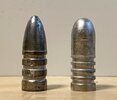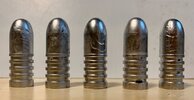This morning I cast some bullets using the alloy I have descriebd above.
I did it using a different mold than I had been using. The Lee aluminum 485g mold had produced bullets that were VERY accurate at 100 yards (3-shot groups as small as 0.62"), but at 150 yards and beyond, they would not group. Checking my Labradar results, I saw that these bullets were going transonic at about 125 yards. Evidently, they did not handle that transition at all well.
So, I did this morning's casting using a Lyman iron 500g mold that was brand new. I had cleaned it thoroughly, and smoked it using a Butane lighter, and preheated it somewhat on the preheating plate on my Lyman Mag 25 25 lb furnace.
The Lyman mold produces a bullet very different in shape from that produced by the Lee mold. here is a photo of the 2 different bullets,, with the Lee bullet on the left and the Lyman on the right:

Note that despite the Lyman bullet being 15g heavier, it is still SHORTER than the Lee bullet. Note also that the Lyman head is also longer as well as fatter. Note that the Lee bullet has 3 lubricant grooves, while the Lyman has 4. The lube groove difference is interesting to me NOT because the Lyman bulelt has an extra groove, for lubricant, since I will be pwoder coating these, just as I did the Lee bullets I had previously cast. Rather, the extra groove might help to break up any transonic shock waves or other transonic effects.
Early results were not good. The iIRON mold was not nearly hot enough after the 23.5 lb of alloy in the pot reached my initial temperature target of 670F. Lots of "wrinkles, and many of the bullets did not want to fall out of the mold when I opened the mold. Casting more bullets to heat up the mold helped a bit, but the bullets still had wrinkles. So I did TWO things (because I limited on time so did both at once):
- I upped the pot temperature a couple of times, from 670F to 700F and then to 720F
- I added 0.25 lb of Tin (about 1% of the 23.5 lb of alloy in the pot)
Things improved!
Within a relatively small number of additional bullets cast, I began getting wrinkle-free bullets that usually dropped out of the mold without having to strike the handle hinge bolt. And, the pour rate from the bottom valve on the pot was faster and noticeably smoother and more controllable.
I cast a total of 137 bullets, of which:
19 were unquestionably bad quality (wrinkles, small voids in the base or profile of the bullet)
16 are what I am temporarily calling "maybe" in terms of usability
102 that look good to me.
Here is a photo of 5 of the bad ones:

The defects get progressively worse in this photo, from left to right:
No. 1 on the left has visible wrinkles that you cannot FEEL, just SEE. I don't know if that disqualifies that bullet altogether for usability?
No. 2 is similar
No. 3 is similar. Its wrinkles are more visible, but still cannot be FELT.
No. 4 has a serious void in the bottommost lube groove.
No. 5 has TWO voids within its lube grooves AND if you look closely at it, you can see where the mold parting line is visible. This bullet, and a few others early in the casting sequence, actually exhibited little lead "whiskers" at the mold parting line. Does this mean that I was not squeezing the mold handles enough, or is this a symptom of something different?
I am also wondering, on those bullets I referred to as in the "maybe" quality category: Those have no voids, and no "feelable" wrinkles, but you can SEE some wirnkle type patterns on them. Are they usable, or will they perform in a substandard way?
I don't know how any of these Lyman mold 500g bullets will shoot. I'll have to powder coat some, and load some cartridges up at different powder levels for a ladder test. I intend to try a BROAD velcoity range, from as high as 1350 fps to as low as 1060 fps, to see if the transonic speed range is a problem or not with this bullet.
Jim G



